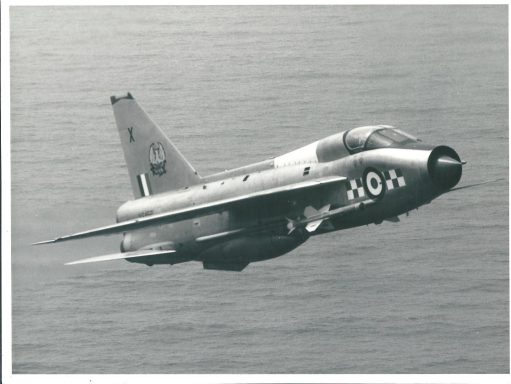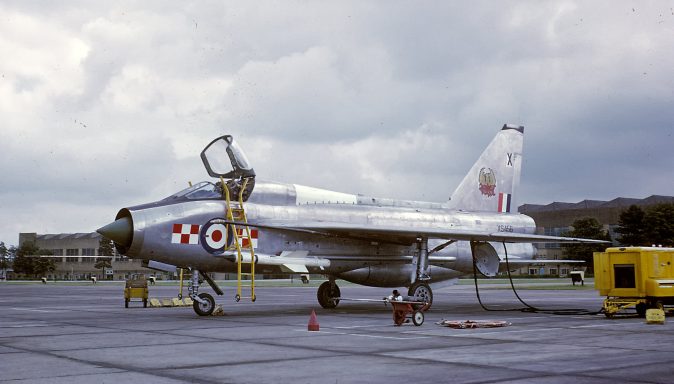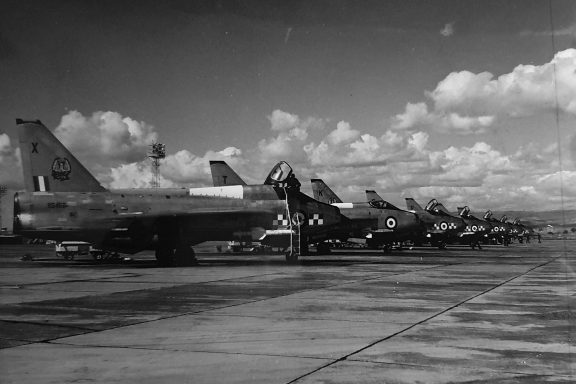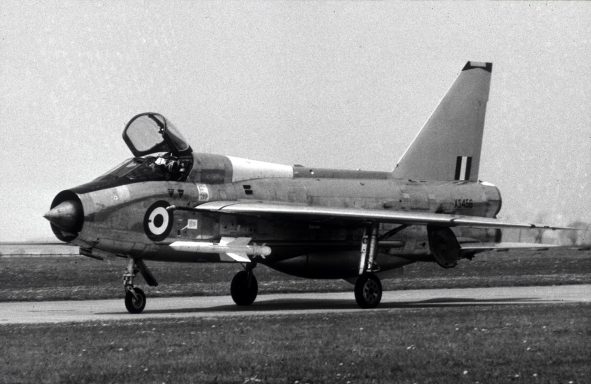XS456 History
XS456 was to take to the air for the very first time on 26th October 1965, with T.M.S. Ferguson at her controls. All initial test flights on her were carried out from Samlesbury where the majority of the Lightnings built were tested. A further eleven flights were eventually carried out over the following months before she was finally passed ready to join her first operational squadron; this was to be in the form of No.56 Sqdn based at RAF Wattisham.
The 20th December 1965 saw her placed on the ‘awaiting collection’ register and the following day she was officially assigned to No.56 Sqdn with only 5.46 hours on the airframe. Upon the completion of the transfer she was designated with the tail code ‘A’ and put straight to work on training the next generation of fast jet pilots.
The following year she continued in her training role under the command of No.56 Sqdn flying out of RAF Wattisham, it would also see her first overseas trips. The first of these would come on the 6th July when she was flown by Sqn Ldr Boyer to Ramstien AFB, Germany, to take part in exchange ‘Fawn’. This was quickly followed up when she was chosen to take part in Malta Adex, flying out to RAF Luqa, Malta on 8th October. The exercise was designed to test the Air Defenses of the island in case of attack and was accompanied by a variety of other aircraft types. Although out of all the lightnings taking part, she was the only T.5. On the final day of the exercise she was to take part in the final Flag-waving flight around the island on 18th October 1966, before returning home to RAF Wattisham on the 20th October. This would ultimately turn out to be the final flying of all Lightning’s in Malta.
As was the norm amongst the different lightning squadrons, 1967 would see her thrown in to the mix of aircraft rotations. The first of these would take place on 17th January 1967 when she was transferred to 60 MU (Maintenance Unit) after an incident on the dispersal the previous day. However, her stay here was to be short lived and on 27th January, she was returned to her squadron. But again, her stay here was also short with her being assigned to the stations TFF (Target Facilities Flight) on 23rd February.
Once more this move was only a short term one and she was assigned back to No.56 Sqdn on the 3rd April. But the following month would see her one and only major trip overseas with her deployment to RAF Akrotiri, Cyprus. After a 4-hour flight from RAF Wattisham she touched-down on 11th June 1967, by this point she still only had 298.35 hours on the airframe. Her flying time initially upon arrival was very minimal due to a variety of mechanical problems and her first few months on foreign soil were spent grounded, although this was mainly due to a lack of spares not only for her, but all the Lightning’s in general on the station.
1968 would see her first major incident, when while climbing-out from 8,000ft at the hands of John May she suffered a seized No.1 engine. Thankfully for all involved she landed safely back at RAF Akrotiri and a new engine was installed. But this was not to be the only incident the Lightnings on deployment were to suffer, with many engine problems being reported, the majority of which being engine compressor damage. This culminated in Dennis Whitham arriving on the station directly from Rolls-Royce during early January 1969 to help solve the problem. Shortly after the arrival of Mr. Whitham, she was chosen to be used on several test flights over the coming days with Mr. Whitham in the starboard seat, in an attempt to rectify the problem. Thankfully after several flights the problem was solved, and normal operational sorties continued once again.
The same month would also bring another change for her in the form of a new tail code, with her becoming ‘X’ and her former tail code (A) going to the recently arrived XR750. The remainder of year would see no further incident or change, but the following year would see her return to the UK on 20th January 1970, for urgent fire modifications and extensive electrical work, which was carried out by 103 MU. This work was completed during May the same year and she returned to Cyprus to continue her duties on 20th May 1970. The following year would see her once again return to 103 MU, when on 4th April 1971, she returned for embody priority fire modifications. These would only take a few weeks and on 17th April she was once again back in Cyprus continuing her normal duties.
Here she would remain on foreign soil without further incident until 23rd February 1973, when she returned for a major service under 60 MU at RAF Leconfield. On completion of the service on 17th February 1974, but instead of returning to No.56 Sqdn who were still out in Cyprus, she was assigned under the control of No.11 Sqdn who were stationed at RAF Binbrook. Along with her new squadron and surroundings, she was also to also receive another new tail code, ‘Z’. Along with the new tail code came a new color scheme, with her changing from the silver she had worn since production, to camouflage. Having been in service for nearly 9 years by now, she was still going strong structurally and had only amassed 1275.40 hours on the airframe. But her stay with the squadron was to be short lived and on 9th December 1974, she was transferred to the ASSF (Aircraft Storage & Support Flight). Here she would remain for the next two and half years only being used to fill in the gaps on the resident squadrons.
It wasn’t until 21st February 1977, that she would move again, this time being placed under the control of the LTF (Lightning Training Flight) but still stationed at RAF Binbrook. Along with this came a new tail code, this time ‘T’. But more change was to come only a year later when she was transferred back to the ASSF on 4th April 1978. Thankfully her services were required once again only a few short months later, and she was transferred back to the LTF on 24th July.
Here she would stay for the next few years training the many next generation of fast jet pilots. Another new tail code (‘DT’) was assigned during November 1980. But once again change was on the horizon and on the 29th January 1981, she was placed back under the control of the ASSF and once again only playing only a bit part role in front line operations and training. She was to receive a reprieve though only a few months later when she was loaned to No.11 Sqdn, but as was becoming the pattern now, this too was to only last for a few short months when on 26th August 1981, she returned under the control of the LTF.
Everything would remain quiet for her until 18th February 1983, when returning from a routine flight she was involved in a near miss while landing and narrowly avoided some very heavy damage.
She was to continue in her operational training role with the LTF for the next few years until as per the norm there was yet more change. The 10th April 1984, saw her transferred to the LESF (Lightning Engineering Service Flight) also at RAF Binbrook. But before this change was to happen, she would take part in exercise ‘Elder Forrest’ operating out of RAF Gütersloh, Germany. Her role in this exercise was to play the part of a Russian MiG and a dayglow red star was placed on her tail to signify this.
By 1985, the hours on her airframe were starting to build and in mid-May she was pulled in for a major service. This would see her taken out of action for nearly a full year due to the size and complexity of this type of service.
But by the time she entered back on the serviceable aircraft rota, rumors of the Lightning era coming to an end had started to circulate. But despite this she was to be once again placed back on operational pilot training, when transferred back to the LTF and re-tail coded one last time to ‘DX’ on 7th April 1986.
This was to be her final tail code, as by this point in time it had been confirmed by the MoD that the Lightnings were to be phased out of service and replaced by the Tornado. Ultimately, this led to her being placed back with the LESF only 3 months later, on 11th July 1986.
With the curtain almost closed her operational service life, she was to have one last stint on operational training when only a few weeks later, on 31st July, she was once again placed back under the control of the LTF. She would remain in this role until 21st April 1987, when she placed under the control of the MEAS (Mechanical Engineering Air Squadron) and here she would stay until her withdrawal from operational service with the RAF.
Her draw-down began with taking part in the final LTF Fly-by’ and ‘beat-up’ on 16th April 1987. The event was the brain child of Sqn Ldr Clive Rowley (OC LTF), who wanted to mark the disbandment of the LTF. Eight aircraft were flown for the one-off event with her flying as ‘Lion 4’ in the formation. At her controls was none other than the current Station Commander, Gp Capt John ‘Spon’ Spencer, plus an invited guest in the right-hand seat.
The following weeks would see her filling in the gaps on the serviceable aircraft rota on both No.5 & 11 Sqn’s whilst still operating out of the ex LTF hangar. This would continue until 18th May, when she was moved to 1 LESF, and then moved again into storage in ASF (Aircraft Storage Flight) on 4th June. At this point she was only a few weeks away from saying her final goodbye to the skies and eventually made her final flight on 18th June 1987. Her final public appearance would come a few months later, on 22nd August, when she was placed on the static display in front of the control tower for the very wet final RAF Binbrook Open Day.
This was the end of her in the public spot light and she was to be moved yet again when returned to 1 LESF on 2nd September, for completion of her spares recovery. This lasted for just over a week and then she was returned to the ASF hangar on 11th September. Here she would remain for the remainder of the year. However, her stay undercover was to come to an end on 24th April 1988, when she was placed for disposal and moved to line 4 out on the airfield, but still marked XS456 on the starboard side. The axe would finally come down on the 27th April 1988, when she was struck off charge and put up for tender by the MoD.
It was on the 13th July 1988, that her military life would come to an end and her civilian one began when she was purchased by T.A. Smith & Co (TASCO). Subsequently, this would place her firmly in the history books forever as the very first Lightning to leave RAF Binbrook.
She was moved from RAF Binbrook to TASCO’s yard in Wainfleet on 20th July 1988. Here she was re-assembled and eventually placed on static display next door at Elms Golf Centre, Wainfleet.
© Copyright, All rights reserved. 2015-2025 XS456 Lightning T.5
We need your consent to load the translations
We use a third-party service to translate the website content that may collect data about your activity. Please review the details in the privacy policy and accept the service to view the translations.
